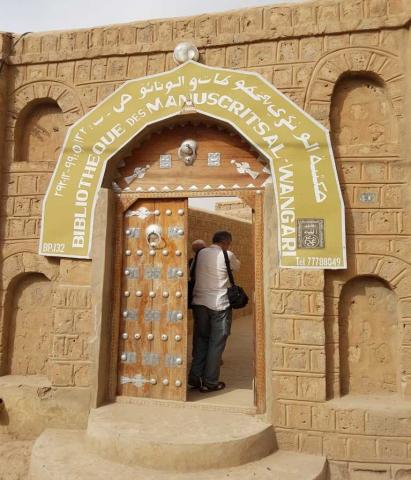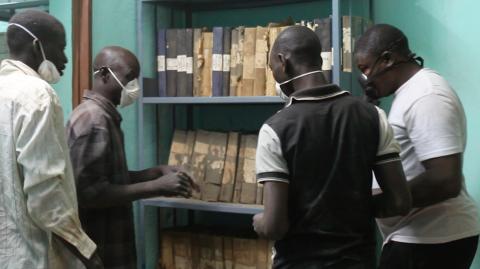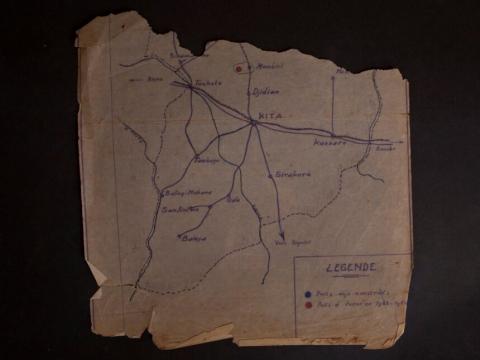Aims and objectives
The city of Djenné has existed since the end of the 8th century. It embraced Islam from the 12th century onwards and gradually became an important centre of trade and Islamic learning, alongside its ‘twin city’ of Timbuktu, which shares many aspects of its history. As an important city of learning and commerce for over a thousand years, it has a very large deposit of Arabic manuscripts.
The previous pilot project EAP269 in 2009 discovered nearly 3,000 manuscripts in 13 family collections. However, it was often evident that only a small proportion of the collection was shown to the team. Therefore, it is still impossible to evaluate the amount of manuscripts that exists in Djenné. The overwhelming majority of the material is copied in Djenné on paper using Sudani type of Arabic script. Some manuscripts are written in local languages in Arabic script.
The majority of the manuscripts date from 1700 to 1900 although some may date from as far back as the 12th century. The condition of the documents varies enormously, although the majority are in a condition to be copied. The manuscripts held in the libraries are relatively safe, although sufficient measures need to be introduced regarding their safekeeping in acid-free boxes. However the manuscripts held privately often exhibit serious deterioration, with damage from termites and from water during the rainy season.
Both Djenné and Timbuktu have been famous for a thousand years as centres of Islamic learning. Even today Djenné boasts about 50 Koran schools where little ‘talibes’ or ‘garibous’ learn verses from the Koran by heart, under the guidance of their Koran master, a Marabout. However, Djenné in particular is also famous for another sort of learning: the Djenné Marabouts are known throughout West Africa as experts of Maraboutage. The pilot project found that more than 50% of the Djenné manuscripts dealt with ‘esoteric’ subjects. It is probable that this is a much higher percentage than the Timbuktu manuscripts, which deal in the main with more orthodox Islamic subjects.
These manuscripts will surely be of immense interest to scholars in the fields not only of religious history and anthropology but of West African history in general. In addition to the large number of esoteric manuscripts roughly half of the manuscripts of Djenné deal with many other subjects as varied as medicine, astronomy, history and poetry. There are 2286 manuscripts in the Djenné Manuscript Library, containing approximately 150,000 pages. In addition there are the 2,885 manuscripts found during the Pilot Study. Many of these manuscripts will have to be digitised in situ at the home of the manuscripts owners. There are also those in two recent private libraries, that of the Imam Korabora and the Landoure family library. A selection will have to be made because of the very large number of manuscripts available. Those chosen for digitisation would have to fulfil certain criteria of either age or distinction in subject matter, in rarity, or in physical appearance.
Concurrent with the digitisation process, courses and study days on various aspects of manuscript and library science will be held for the benefit of the manuscript owners, to raise their awareness of the value of their manuscripts. In addition the technicians digitising the manuscripts will impart their knowledge to a select group of locals during the project.
A reading room for the digitised collection will be put in place at the Djenné library, and a website to host the collection. There is a need to store the collection of manuscripts at the Djenné library in acid free boxes for their safe keeping, and at least 300 of the most important manuscripts will be stored as a result of the project.
The project features in this article in The New York Times, published in April 2012. Read articles written by the grantholder Sophie Sarin, published in The Art Newspaper and on The Arts Desk
Visit the website of the Djenné Manuscript Library
Discussion broadcast by the BBC Radio 3 programme Night Waves on 31 January 2013.
Dr Shamil Jeppie, Director of the Tombouctou Manuscripts Project; Dr Marion Wallace, Lead Curator of African Studies at the British Library; and novelist Aminatta Forna join Anne McElvoy in discussing the libraries in Timbuktu and book culture in Africa, including the work of the Endangered Archives Programme.
[MP3, 15mins 3sec, 2KB].
Reproduced here by kind permission of BBC Radio 3 Night Waves.
Outcomes
At the beginning of the project, the Djenné Library Manuscript collection held a total of 2,172 manuscripts, from 33 families. During the two years of the project, the population of Djenné gradually began to trust the team of archivists and an increasing number of families brought their collections to the library, with the result that today the Djenné Manuscript Library is the custodian of the collections of nearly 70 Djenné families, and holds over 4,000 manuscripts.
The project has digitised just under 150,000 pages, a smaller number than originally estimated. This is due to the fact that virtually the entire two year project has been carried out in extreme conditions. Mali is only just emerging from 18 month of severe political crisis which has included a coup d’etat and a war. The library staff have nevertheless achieved a remarkable result, considering that the electricity supply has sometimes been cut for several days at the time.
During the first months of the project the staff received training in order to carry out their respective tasks and a course was held to train our acid-free box makers, who were able to make 318 boxes to house manuscripts from the various family collections.
The family archives are kept on wooden shelving in cupboards fronted with protective netting in the library where they are relatively safe. 318 manuscripts are housed in the acid free boxes.
One copy of the digital collection will be deposited at the National Archives in Bamako in the beginning of October, when a ceremony will both end the EAP488 and mark the beginning of the next phase of the project, EAP690. One copy has been deposited with the British Library.
Read online the open access article: In the shadow of Timbuktu: the manuscripts of Djenné, published in the EAP Anniversary publication From Dust to Digital. The article can also be downloaded as a PDF (447KB).
The records copied by this project have been catalogued as:
- EAP488/1 Djenne Manuscript Library Collection [c15th century-c20th century]
Due to the cyber-attack on the British Library in October 2023, the archives and manuscripts database is currently inaccessible and we are unable to provide links to the catalogue records for this project.




